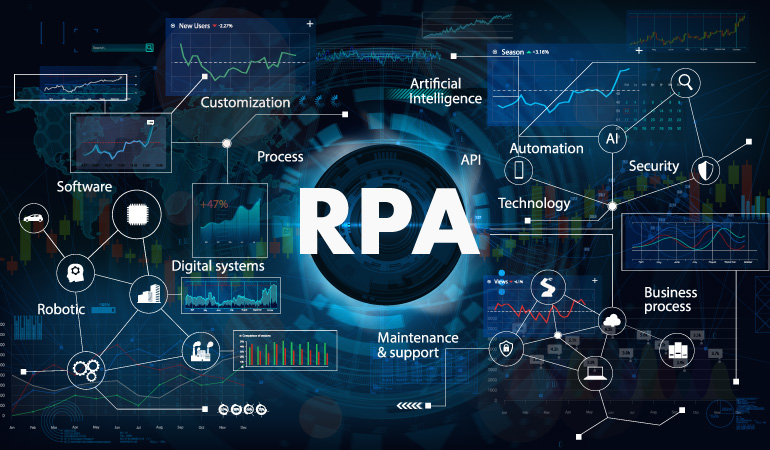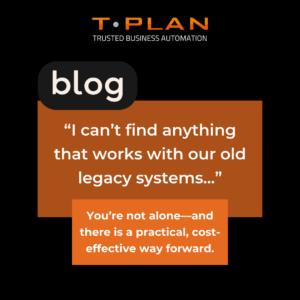Back-office RPA: challenges, testing strategies and best practices
Many businesses still rely on outdated back-office systems that were never designed for modern automation. These legacy applications – whether running on Windows XP, Windows 7, Sage or older billing platforms – continue to power essential business operations. However, they present a significant challenge: how do you introduce automation without breaking critical workflows?
Back-office automation eliminates repetitive tasks in finance, HR, customer service and billing through Robotic Process Automation (RPA) and other technologies. But without proper testing, automation can lead to data corruption, invoicing errors, compliance failures and system disruptions.
This article explores the challenges of back-office automation, key testing considerations, effective strategies and best practices, ensuring businesses can implement reliable, scalable and risk-free automation.

Table of Contents
Understanding back-office automation
What is back-office automation?
Let’s start from the beginning. Back-office automation involves streamlining internal business operations by automating repetitive, rule-based processes. These tasks are often manual, time-consuming and prone to human error. Examples include:
- Finance – Automating invoice processing, financial reporting and reconciliation.
- HR – Payroll management, onboarding workflows and employee record maintenance.
- Customer service – AI-powered ticket management, automated responses and data entry.
- Billing & compliance – Subscription renewals, regulatory reporting and automated invoicing.
RPA plays a crucial role in reducing manual effort, improving efficiency and enhancing compliance. Unlike traditional integrations, RPA does not require modifying system code; instead, it interacts with applications through their user interfaces (UIs). This makes it a preferred approach for automating legacy applications that lack API support.
However, automating back-office systems is not without its challenges. Many legacy applications present technical and operational hurdles that must be addressed before automation can be deployed effectively.
Challenges of automating legacy back-office systems
Legacy systems pose significant obstacles to automation due to their age, architecture and lack of integration capabilities. Some key challenges include:
- No API support – Many older systems do not provide direct API access, forcing automation to interact via UI-based workflows.
- Frequent UI changes – Even minor interface modifications can break automation scripts, leading to maintenance challenges.
- Inconsistent performance – Legacy applications often experience slow response times, pop-ups and unpredictable behaviours, making automation unreliable.
- Data handling complexities – Older databases may use outdated formats or lack validation mechanisms, increasing the risk of data corruption.
Given these challenges, businesses cannot simply implement automation and assume it will work flawlessly. Instead, they must take a structured approach to testing, ensuring that automation workflows remain stable, secure and efficient.
Why testing back-office automation is essential
Testing plays a critical role in ensuring that back-office automation operates exactly as intended. Without proper testing, automation failures can lead to serious business risks:
- Data integrity issues – Errors in financial transactions, payroll calculations or CRM records.
- Workflow failures – Automation breaking due to UI changes, pop-ups or system crashes.
- Security vulnerabilities – Bots mishandling sensitive customer and financial data.
- Operational disruptions – An automation failure could result in lost transactions or inaccurate data processing.
Key testing considerations for back-office RPA
To mitigate these risks, businesses need a robust testing strategy that verifies automation reliability before deployment. This requires a focus on data integrity, performance, UI interactions and error handling.
Ensuring data integrity and accuracy
Since back-office automation frequently interacts with financial, HR and customer data, ensuring accuracy is critical. Errors in data processing can lead to compliance violations, financial losses and operational disruptions.
A structured validation approach is essential to confirm that automation correctly captures, processes and transfers data. This includes cross-system reconciliation, where financial reports generated by automation are compared against manual records to detect discrepancies. Audit logs and reporting mechanisms should also be in place to track automation actions and identify potential issues before they escalate.
To ensure automation remains reliable under real-world conditions, businesses must test workflows under various operational scenarios.
Simulating real-world conditions
Back-office automation must function reliably under different system conditions, network speeds and user interactions. To prevent failures, testing should include:
- Network variability testing to ensure automation operates correctly under different speeds and latencies.
- UI delay handling to confirm that bots can manage slow-loading screens, pop-ups and unexpected UI changes.
- High transaction volume testing to validate that automation remains stable during peak business hours.
Explore our in-depth guide on RPA testing: T-Plan RPA Testing Guide
Testing UI-based automation in legacy systems
Since many back-office systems lack API access, UI-based automation must be tested for reliability. One effective approach is to use visual automation tools that rely on image recognition and Optical Character Recognition (OCR) to interact with legacy applications.
Testing should also evaluate how automation behaves under different screen resolutions and UI variations. If an application is used in different display settings, automation scripts must remain functional despite minor UI changes.
Exception handling and error recovery
A strong testing strategy includes error simulation, where automation is intentionally exposed to failure scenarios to verify its ability to recover. Testing should ensure that RPA bots can:
- Detect and respond to unexpected application errors.
- Generate detailed error logs for troubleshooting and analysis.
- Retry failed transactions and restart workflows when needed.
With a structured testing approach in place, businesses can effectively manage automation risks and maintain system reliability. The next step is selecting the right testing tools and strategies to optimise automation performance.
Testing strategies for back-office automation
As businesses integrate automation into their back-office workflows, choosing the right testing strategy becomes essential. The complexity of legacy systems means that testing must go beyond simple validations – continuous testing is required to ensure long-term stability. The effectiveness of manual vs. automated testing, the role of visual automation tools, and the importance of regression and performance testing must all be carefully considered.
Manual vs. automated testing approaches
In the early stages of automation, manual testing is essential for initial validation of RPA workflows and handling edge cases. However, manual testing is time-consuming, difficult to scale, and prone to human error. As automation expands, automated regression testing becomes crucial. With frequent system updates, businesses need a consistent, repeatable testing process to verify that bots continue to operate correctly. Automated testing ensures that any UI or system changes do not break existing workflows.
Visual automation testing with T-Plan robot
For legacy applications that lack API access, automated testing must rely on visual-based verification rather than direct data validation. This is where T-Plan Robot excels, offering a powerful UI-based testing solution. Unlike traditional automation tools that rely on APIs, T-Plan Robot enables non-invasive testing by interacting with applications at the UI level.
Regression testing for stability
Regression testing ensures that RPA workflows remain stable over time. By maintaining a library of reusable test cases, businesses can quickly validate automation scripts after system changes, minimising downtime and maintenance costs.
Learn more: T-Plan Regression Testing
Performance and load testing for RPA workflows
Automation must be able to handle high transaction volumes and peak business hours without performance degradation. Load testing helps identify potential bottlenecks, ensuring that automation operates efficiently under varying conditions.
Best practices for testing back-office automation
Implementing these strategies effectively requires following proven best practices:
- Maintain detailed test documentation – Ensure test cases, logs and error reports are well-documented.
- Use sandbox environments – Avoid testing automation in live production systems.
- Implement security testing – Protect sensitive financial and HR data from security risks.
- Regularly update automation scripts – Prevent failures due to UI updates or workflow changes.
- Monitor automation performance – Use real-time tracking and analytics to identify potential issues.
Using T-Plan for back-office automation testing
While following best practices ensures automation stability, choosing the right testing platform is just as important. Legacy systems require a specialised testing approach that accounts for UI-based automation, slow system performance and frequent UI changes – challenges that traditional automation tools struggle to handle.
T-Plan provides a powerful, non-invasive testing solution that is uniquely suited for back-office automation in legacy environments.
Why T-Plan is ideal for legacy system automation
Unlike many modern automation tools that rely on API-driven testing, T-Plan enables full UI-based automation, making it the perfect choice for businesses running non-API legacy applications.
T-Plan offers:
- Visual-based automation – Works seamlessly with older systems by recognising on-screen elements rather than requiring API access.
- Image recognition & OCR – Automates workflows in applications that lack structured data access, such as old billing or finance systems.
- Cross-platform compatibility – Supports Windows XP, Windows 7 and virtualised environments, ensuring automation works across different system versions.
- Non-invasive implementation – Does not require modifying legacy software, reducing risk and maintaining full system compatibility.
Key features of T-Plan for back-office RPA testing
T-Plan’s automation and testing capabilities allow businesses to test, monitor and optimise their RPA workflows with confidence:
- Visual testing capabilities – Uses screen and UI recognition to automate interactions.
- Exception handling & recovery – Detects automation failures and ensures bots can recover gracefully.
- Scalability & flexibility – Adapts to various testing needs, from finance to HR and customer service automation.
Explore T-Plan’s cross-platform testing solutions: T-Plan Automation Tools
How to implement T-Plan in your automation testing strategy
To successfully integrate T-Plan into back-office automation testing, businesses should follow a structured approach:
- Identify legacy applications that require UI-based automation.
- Develop detailed test cases to ensure thorough validation of workflows.
- Use T-Plan’s visual automation tools to simulate real-world interactions with legacy systems.
- Continuously monitor and refine automation scripts to maintain stability and performance.
By leveraging T-Plan’s advanced automation testing, businesses can ensure reliability, reduce maintenance effort and future-proof their back-office automation initiatives.
Conclusion:
Testing back-office automation is critical to prevent data corruption, compliance failures and business disruptions. Without rigorous testing, automation failures can lead to financial losses and operational inefficiencies.
T-Plan provides a powerful, scalable solution for testing and automating legacy systems.
Ensure your back-office automation is reliable – Try T-Plan’s testing solutions today!


